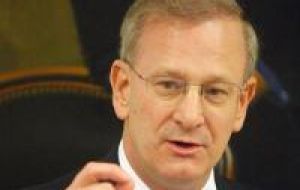MercoPress. South Atlantic News Agency
Fed leaves rates unchanged but will begin to wind down liquidity programs
 Kansas City Fed president Thomas Hoenig, the dissenting voice
Kansas City Fed president Thomas Hoenig, the dissenting voice The Federal Reserve said on Wednesday that the U.S. economic activity has continued to “strengthen” and decided to keep a key interest rate unchanged at a record low of between zero to 0.25% to prop up the economy. However there was a dissenting vote.
The release from the Federal Open Market Committee, FOMC, said Information received recently “suggested that economic activity has continued to strengthen and that the deterioration in the labour market is abating”. Furthermore in recent weeks household spending is expanding at a moderate rate but remains constrained by a weak labour market, modest income growth, lower housing wealth, and tight credit, adds the release following a two-day policy-making meeting in Washington.
Meanwhile, business spending on equipment and software appears to be picking up, “but investment in structures is still contracting and employers remain reluctant to add to payrolls”.
Although the pace of economic recovery is likely to be moderate for a time, the Fed anticipates a gradual return to higher levels of resource utilization in a context of price stability. “With substantial resource slack likely to continue to dampen cost pressures and with longer-term inflation expectations stable” the Fed anticipates “inflation is likely to be subdued for some time.”
Moreover, the Fed said that the interest rate is likely to remain at the current low level for “an extended period” and reaffirmed its commitment “to provide support to mortgage lending and housing markets and to improve overall conditions in private credit markets.“
As announced in previous meetings, the Fed will purchase a total of up to 1.25 trillion dollars of agency mortgage-backed securities. But the US central bank said it would buy about 175 billion dollars of agency debt, less than the maximum of 200 billion dollars it had originally announced.
The Fed said it ”is gradually slowing the pace of these purchases, and it anticipates that these transactions will be executed by the end of the first quarter“. With credit clogs easing, the U.S. central bank said it plans to wind down by March 8 a program, dubbed the Term Auction Facility, that provides banks with low costs loans.
In addition, it noted that it will dismantle a handful of other emergency lending programs set up during the financial crisis on February first when they are set to expire.
Kansas City Fed president Thomas Hoenig, the dissenting voice, voted against the decision to keep the key interest rate steady. He believed that ”the expectation of exceptionally low levels of the federal funds rate for an extended period was no longer warranted“.
The US economy expanded at a pace of 2.2% in the third quarter of 2009 after four consecutive quarters of contraction, a signal that the worst recession since the Great Depression has ended. However, the third-quarter gain was 0.6 percentage point lower than the 2.8 percent growth rate estimated on November 24, and 1.3 percentage point lower than its first estimate released on October 29.
Meanwhile Japan's central bank also kept its key interest rate unchanged at just above zero while underlining its determination to overcome deflation.
As widely expected, the board of the Bank of Japan unanimously opted to keep interest rates at 0.1%. It said the world's second largest economy was improving, but further government support was needed to maintain the recovery.
The board also said overcoming deflation was a ”critical challenge”.




Top Comments
Disclaimer & comment rulesCommenting for this story is now closed.
If you have a Facebook account, become a fan and comment on our Facebook Page!